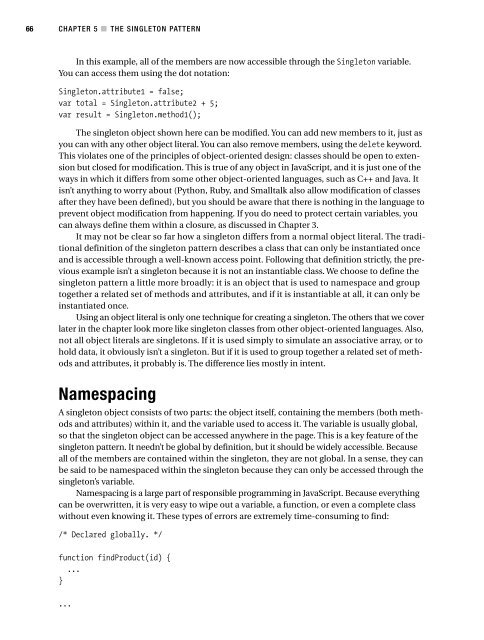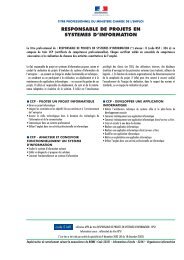Design Patterns
Download - Assembla
Download - Assembla
- No tags were found...
You also want an ePaper? Increase the reach of your titles
YUMPU automatically turns print PDFs into web optimized ePapers that Google loves.
66<br />
CHAPTER 5 ■ THE SINGLETON PATTERN<br />
In this example, all of the members are now accessible through the Singleton variable.<br />
You can access them using the dot notation:<br />
Singleton.attribute1 = false;<br />
var total = Singleton.attribute2 + 5;<br />
var result = Singleton.method1();<br />
The singleton object shown here can be modified. You can add new members to it, just as<br />
you can with any other object literal. You can also remove members, using the delete keyword.<br />
This violates one of the principles of object-oriented design: classes should be open to extension<br />
but closed for modification. This is true of any object in JavaScript, and it is just one of the<br />
ways in which it differs from some other object-oriented languages, such as C++ and Java. It<br />
isn’t anything to worry about (Python, Ruby, and Smalltalk also allow modification of classes<br />
after they have been defined), but you should be aware that there is nothing in the language to<br />
prevent object modification from happening. If you do need to protect certain variables, you<br />
can always define them within a closure, as discussed in Chapter 3.<br />
It may not be clear so far how a singleton differs from a normal object literal. The traditional<br />
definition of the singleton pattern describes a class that can only be instantiated once<br />
and is accessible through a well-known access point. Following that definition strictly, the previous<br />
example isn’t a singleton because it is not an instantiable class. We choose to define the<br />
singleton pattern a little more broadly: it is an object that is used to namespace and group<br />
together a related set of methods and attributes, and if it is instantiable at all, it can only be<br />
instantiated once.<br />
Using an object literal is only one technique for creating a singleton. The others that we cover<br />
later in the chapter look more like singleton classes from other object-oriented languages. Also,<br />
not all object literals are singletons. If it is used simply to simulate an associative array, or to<br />
hold data, it obviously isn’t a singleton. But if it is used to group together a related set of methods<br />
and attributes, it probably is. The difference lies mostly in intent.<br />
Namespacing<br />
A singleton object consists of two parts: the object itself, containing the members (both methods<br />
and attributes) within it, and the variable used to access it. The variable is usually global,<br />
so that the singleton object can be accessed anywhere in the page. This is a key feature of the<br />
singleton pattern. It needn’t be global by definition, but it should be widely accessible. Because<br />
all of the members are contained within the singleton, they are not global. In a sense, they can<br />
be said to be namespaced within the singleton because they can only be accessed through the<br />
singleton’s variable.<br />
Namespacing is a large part of responsible programming in JavaScript. Because everything<br />
can be overwritten, it is very easy to wipe out a variable, a function, or even a complete class<br />
without even knowing it. These types of errors are extremely time-consuming to find:<br />
/* Declared globally. */<br />
function findProduct(id) {<br />
...<br />
}<br />
...











